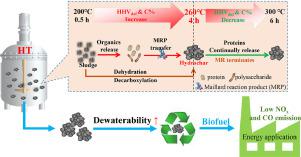Water Research ( IF 12.8 ) Pub Date : 2021-04-21 , DOI: 10.1016/j.watres.2021.117170 He Zhang , Gang Xue , Hong Chen , Xiang Li , Shanping Chen

|
Hydrothermal treatment (HT) is a promising method to convert sewage sludge to hydrochar biofuel. The heating value is directly correlated to the carbon content in hydrochar; however, the release of organic matter from sludge to hydrolysate and the transfer of the Maillard reaction products generated in the hydrolysate to the solid phase alter the carbon content in hydrochar. In this study, the relationship between hydrolysate and heating value of sludge-based hydrochar was presented, aiming to explain how the calorific value of hydrochar was affected by HT conditions. We adopted a direct combustion test to verify its clean combustion features. Hydrochar derived at 260 °C and residence time of 4 h (HC 260-4) exhibited the highest calorific value (HHVdaf = 26.23 MJ/kg) with an energy density of 1.43, and its fuel characteristics were similar to those of lignite. The increase in the HT temperature and residence time up to 260 °C and 4 h, respectively, was beneficial for enhancing HHVdaf. Conversely, further increase of the HT temperature to 300 °C and HT time to 6 h yielded a decrease in HHVdaf. Investigation of the underlying mechanism revealed that the protein and polysaccharide releasing from sludge to hydrolysate occurred the Maillard reaction (MR). The generated humic-like Maillard reaction product (MRP) was transferred to hydrochar, inducing an increase in the carbon content and calorific value and a decrease in the organic content of hydrolysate. As the carbohydrate content in the hydrolysate decreased, the MR was terminated, so no more MRP was transferred to hydrochar. At the same time, the protein was still continuously released at higher temperatures and longer residence times, yielding a decline in the HHVdaf. Moreover, clean energy utilization was verified from the reduced nitrogen content in hydrochar and lower CO and NOx emission of HC 260-4 in the combustion test. After the HT, increased hydrophobicity and a lower fraction of bound water improved the dewaterability, which is of great significance for applying hydrochar as biofuel. The findings of this study provided a new perspective to explain the heating value generation of hydrochar and more direct evidence to assess its clean combustion properties, with promising perspectives for practical applications.
中文翻译:

从水解产物的角度揭示水热过程中污泥基炭的热值特征
水热处理(HT)是一种将污水污泥转化为水焦炭生物燃料的有前途的方法。热值与水煤中的碳含量直接相关。但是,污泥中的有机物释放到水解产物中,水解产物中生成的美拉德反应产物转移到固相中,改变了炭中的碳含量。在这项研究中,提出了水解物与污泥基炭的热值之间的关系,旨在解释高温条件如何影响炭的热值。我们采用了直接燃烧测试,以验证其清洁燃烧特性。在260°C和4 h的停留时间(HC 260-4)下产生的烃类表现出最高的发热量(HHV daf = 26.23 MJ / kg),能量密度为1.43,其燃料特性与褐煤相似。HT温度和停留时间分别增加至260°C和4 h,对于增强HHV daf是有利的。相反,进一步提高HT温度至300°C和HT时间至6 h导致HHV daf降低。对潜在机理的研究表明,从污泥释放到水解产物的蛋白质和多糖发生了美拉德反应(MR)。将生成的腐殖质类美拉德反应产物(MRP)转移到烃中,导致碳含量和热值增加,水解产物的有机物含量降低。随着水解产物中碳水化合物含量的降低,MR终止,因此不再有MRP转移到烃中。同时,该蛋白仍在较高温度和较长停留时间下连续释放,导致HHV daf下降。此外,通过降低碳氢化合物中的氮含量以及降低CO和NO x的使用量,验证了清洁能源的利用。在燃烧测试中排放HC 260-4。高温处理后,增加疏水性和降低结合水含量提高了脱水能力,这对于将水焦炭用作生物燃料具有重要意义。这项研究的发现提供了一个新的视角来解释水焦炭的热值产生,并为评估其清洁燃烧性能提供了更直接的证据,并为实际应用提供了有前途的前景。



























 京公网安备 11010802027423号
京公网安备 11010802027423号